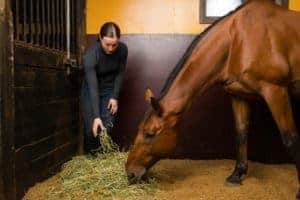Fescue Toxicosis
Mares grazing on tall fescue pastures infected with a toxin have increased gestation lengths, mare and foal deaths, agalactia (absent milk secretion after birth), retained placentas, premature separation of the placenta at birth, and increased placental weights and thickness. The endophytic fungus, called Acremonium coenophialum, lives on the grass and has been reported to cause all of the previously mentioned reproductive problems in mares.
Where is the infected fescue?
This endophyte is prevalent in fescue-growing regions throughout the United States. Fescue toxicosis, however, appears to have regional and seasonal preferences. Veterinarians in the northern regions of the United States report lower toxicity levels, agalactia, and dystocia. However, premature placental separations (“red-bagging”) appear more frequently. On the other hand, a warm or mild winter in the northern states tends to exacerbate toxicosis conditions.
In the more southern fescue-growing regions of the country, count on a high level of fescue toxicosis in mares regardless of the severity of winter weather.
How can you tell if your fescue is infected?
There are many ways to tell if your pasture is infected
Create a free account with TheHorse.com to view this content.
TheHorse.com is home to thousands of free articles about horse health care. In order to access some of our exclusive free content, you must be signed into TheHorse.com.
Start your free account today!
Already have an account?
and continue reading.
Written by:
D.L. Cross, DVM
Related Articles
Stay on top of the most recent Horse Health news with












